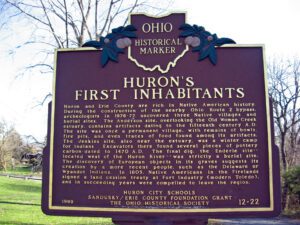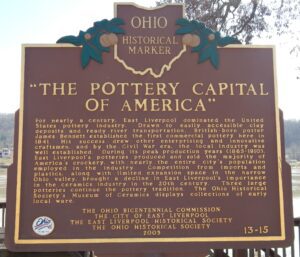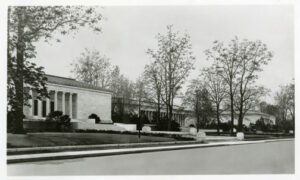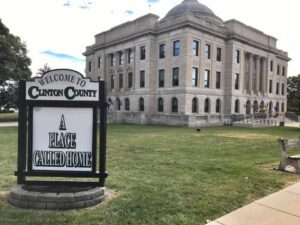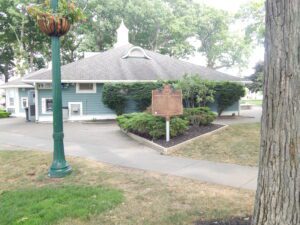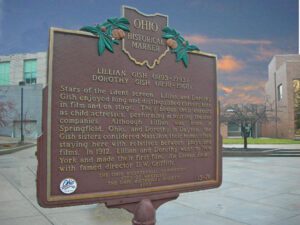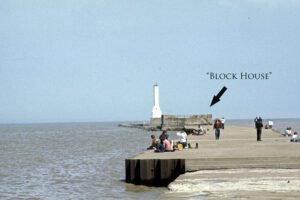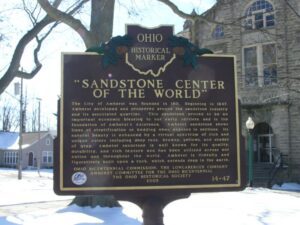, OH
Huron and Erie County are rich in Native American history. During the construction of the nearby Ohio Route 2 bypass, archeologists in 1976-77 uncovered three Native villages and burial sites. The Anderson site, overlooking the Old Woman Creek estuary, contains artifacts dating to the fifteenth century A.D. The site was once a permanent village, with remains of bowls, fire pits, and even traces of food found among its artifacts. The Jenkins site, also near the estuary, was a winter camp for Indians. Excavators there found several pieces of pottery carbon-dated to 1470 A.D. The final dig, the Enderle site — located west of the Huron River — was strictly a burial site. The discovery of European objects in its graves suggests its creation by a more recent people, such as the Delaware or Wyandot Indians. In 1805, Native Americans in the Firelands signed a land cession treaty at Fort Industry (modern Toledo), and in succeeding years were compelled to leave the region.
, OH
For nearly a century, East Liverpool dominated the United States pottery industry. Drawn to easily accessible clay deposits and ready river transportation, British-born potter James Bennett established the first commercial pottery here in 1841. His success drew other enterprising and innovative craftsmen, and by the Civil War era, the local industry was well established. During its peak production years (1865-1910), East Liverpool’s potteries produced and sold the majority of America’s crockery, with nearly the entire city’s population employed in the industry. Competition from imports and plastics, along with limited expansion space in the narrow Ohio valley, brought a decline in East Liverpool’s importance in the ceramics industry in the 20th century. Three large potteries continue the pottery tradition. The Ohio Historical Society’s Museum of Ceramics displays collections of early local ware.
, OH
Founded in 1901 under the leadership of Edward Drummond Libbey, who established the glass industry in Toledo, the Museum building was designed by the architect Edward Green. It was completed in three stages in 1912, 1926, and 1933. From the outset the Museum has aimed to be a community and educational resource in the visual and performing arts.
, OH
The Clinton County Courthouse was dedicated October 22, 1919. The Cincinnati firm of Weber, Werner and Adkins designed the edifice and it is a local masterpiece that fuses the Beaux-Arts and Neo-Classical architectural styles. A grand marble staircase rises from the basement to the second floor. At the center of the cruciform plan is a dome 32 feet in diameter with a stained-glass window. The murals of four women beneath the dome represent Agriculture, Education, Medicine, and Industry, and are known as the Guardians of the Courthouse. The county built courthouse and former jail for a combined cost of nearly $370,000.
, OH
Entrepreneur and philanthropist Joseph (Jose) de Rivera was born in Barcelona, Spain, and built an import business in New York City. In 1854, he bought six Lake Erie Islands and had South Bass Island surveyed and subdivided into ten-acre lots. De Rivera traveled between New York and South Bass Island, initially turning Put-in-Bay into a sheep farm. He encouraged settlement on the island and its wine industry by helping German immigrants purchase land to plant vineyards. He donated five acres for this waterfront park, the site for the first school, and the land for the first church. To promote travel to the island, de Rivera opened the island’s largest cave as a tourist attraction. He is buried in the island’s cemetery, which is on land he donated for that purpose.
, OH
Stars of the silent screen, Lillian and Dorothy Gish enjoyed long and distinguished careers both in film and on stage. They began their careers as child actresses, performing in touring theater companies. Although Lillian was born in Springfield, Ohio, and Dorothy in Dayton, the Gish sisters considered Massillon their home, often staying here with relatives between plays and films. In 1912, Lillian and Dorothy went to New York and made their first film, An Unseen Enemy, with famed director D.W. Griffith.
, OH
Lake Erie commerce has played a central role in the development of Huron. Important among Huron’s maritime industries were shipbuilding and commercial fishing. The city’s shipbuilding industry dates to the first decades of the nineteenth century. Shipyards were located on the Huron River’s west bank, slightly north of this marker, and also upstream at Fries Landing. Among the vessels built at Huron were the Great Western, constructed in 1838 and the first lake ship to have above-deck cabins, and the Golden Age, which, at 286 feet, was the largest craft on the Great Lakes when built in 1886. Huron shipbuilding declined as the nineteenth century drew to a close. Commercial fishing emerged thereafter, serving as Huron’s economic cornerstone for over fifty years. Huron’s fishing enterprises included the Huron, Kishman, Scott, and Zimmerman fish companies. By 1950, however, polluted lake waters ravished the once-lucrative industry. Although shipbuilding and commercial fishing are no longer a part of Huron’s daily life, they each had a profound effect upon the community’s growth for nearly two centuries.
, OH
The City of Amherst was founded in 1811. Beginning in 1847, Amherst developed and prospered around the sandstone industry and its associated quarries. This sandstone proved to be an important economic blessing to our early settlers and is the foundation of Amherst’s existence. Amherst sandstone shows lines of stratification or bedding when exposed in sections. Its natural beauty is enhanced by a virtual spectrum of rich and unique colors including deep reds, browns, yellows, and shades of gray. Amherst sandstone is well known for its quality, durability, and rich texture and has been utilized across our nation and throughout the world. Amherst is literally and figuratively built upon a rock, which extends deep in the earth.


